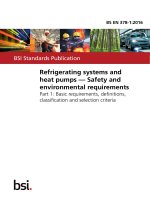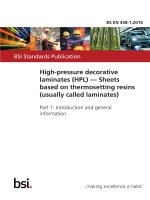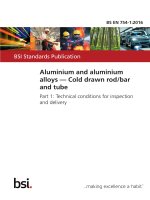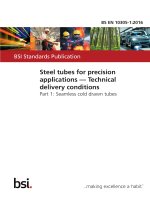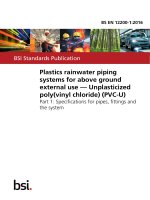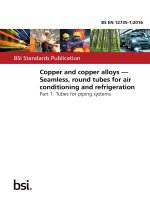Bsi bs en 62129 1 2016
Bạn đang xem bản rút gọn của tài liệu. Xem và tải ngay bản đầy đủ của tài liệu tại đây (2.87 MB, 60 trang )
BS EN 62129-1:2016
BSI Standards Publication
Calibration of wavelength/optical
frequency measurement
instruments
Part 1: Optical spectrum analyzers
BS EN 62129-1:2016 BRITISH STANDARD
National foreword
This British Standard is the UK implementation of EN 62129-1:2016. It is
identical to IEC 62129-1:2016. It supersedes BS EN 62129:2006 which is
withdrawn.
The UK participation in its preparation was entrusted to Technical
Committee GEL/86, Fibre optics.
A list of organizations represented on this committee can be obtained on
request to its secretary.
This publication does not purport to include all the necessary provisions of
a contract. Users are responsible for its correct application.
© The British Standards Institution 2016.
Published by BSI Standards Limited 2016
ISBN 978 0 580 79838 2
ICS 33.140; 33.180.01
Compliance with a British Standard cannot confer immunity from
legal obligations.
This British Standard was published under the authority of the
Standards Policy and Strategy Committee on 30 June 2016.
Amendments/corrigenda issued since publication
Date Text affected
EUROPEAN STANDARD BS EN 62129-1:2016
NORME EUROPÉENNE
EUROPÄISCHE NORM EN 62129-1
ICS 33.140; 33.180.01 June 2016
Supersedes EN 62129:2006
English Version
Calibration of wavelength/optical frequency measurement
instruments - Part 1: Optical spectrum analyzers
(IEC 62129-1:2016)
Étalonnage des appareils de mesure de longueur Kalibrierung von Messgeräten für die Wellenlänge/optische
d'onde/appareil de mesure de la fréquence optique - Frequenz - Teil 1: Optische Spektrumanalysatoren
(IEC 62129-1:2016)
Partie 1: Analyseurs de spectre optique
(IEC 62129-1:2016)
This European Standard was approved by CENELEC on 2016-02-17. CENELEC members are bound to comply with the CEN/CENELEC
Internal Regulations which stipulate the conditions for giving this European Standard the status of a national standard without any alteration.
Up-to-date lists and bibliographical references concerning such national standards may be obtained on application to the CEN-CENELEC
Management Centre or to any CENELEC member.
This European Standard exists in three official versions (English, French, German). A version in any other language made by translation
under the responsibility of a CENELEC member into its own language and notified to the CEN-CENELEC Management Centre has the
same status as the official versions.
CENELEC members are the national electrotechnical committees of Austria, Belgium, Bulgaria, Croatia, Cyprus, the Czech Republic,
Denmark, Estonia, Finland, Former Yugoslav Republic of Macedonia, France, Germany, Greece, Hungary, Iceland, Ireland, Italy, Latvia,
Lithuania, Luxembourg, Malta, the Netherlands, Norway, Poland, Portugal, Romania, Slovakia, Slovenia, Spain, Sweden, Switzerland,
Turkey and the United Kingdom.
European Committee for Electrotechnical Standardization
Comité Européen de Normalisation Electrotechnique
Europäisches Komitee für Elektrotechnische Normung
CEN-CENELEC Management Centre: Avenue Marnix 17, B-1000 Brussels
© 2016 CENELEC All rights of exploitation in any form and by any means reserved worldwide for CENELEC Members.
Ref. No. EN 62129-1:2016 E
BS EN 62129-1:2016
EN 62129-1:2016
European foreword
The text of document 86/477/CDV, future edition 1 of IEC 62129-1, prepared by IEC/TC 86 "Fibre
optics" was submitted to the IEC-CENELEC parallel vote and approved by CENELEC as
EN 62129-1:2016.
The following dates are fixed:
• latest date by which the document has to be implemented at (dop) 2016-12-03
national level by publication of an identical national
standard or by endorsement
• latest date by which the national standards conflicting with (dow) 2019-06-03
the document have to be withdrawn
This document supersedes EN 62129:2006.
Attention is drawn to the possibility that some of the elements of this document may be the subject of
patent rights. CENELEC [and/or CEN] shall not be held responsible for identifying any or all such
patent rights.
Endorsement notice
The text of the International Standard IEC 62129-1:2016 was approved by CENELEC as a European
Standard without any modification.
In the official version, for Bibliography, the following notes have to be added for the standards indicated:
IEC 60793-2-50 NOTE Harmonized as EN 60793-2-50.
IEC 61315 NOTE Harmonized as EN 61315.
IEC 62129-2 NOTE Harmonized as EN 62129-2.
IEC 62522 NOTE Harmonized as EN 62522.
IEC 60359:2001 NOTE Harmonized as EN 60359:2002 (not modified).
IEC 61290-3-1 NOTE Harmonized as EN 61290-3-1.
2
BS EN 62129-1:2016
EN 62129-1:2016
Annex ZA
(normative)
Normative references to international publications
with their corresponding European publications
The following documents, in whole or in part, are normatively referenced in this document and are
indispensable for its application. For dated references, only the edition cited applies. For undated
references, the latest edition of the referenced document (including any amendments) applies.
NOTE 1 When an International Publication has been modified by common modifications, indicated by (mod),
the relevant EN/HD applies.
NOTE 2 Up-to-date information on the latest versions of the European Standards listed in this annex is
available here: www.cenelec.eu.
Publication Year Title EN/HD Year
IEC 60050-731 - - -
International Electrotechnical
IEC 60793-2 series Vocabulary - EN 60793-2 series
IEC 60825-1 - Chapter 731: Optical fibre EN 60825-1 -
ISO/IEC 17025 - communication
ISO/IEC Guide 98-3 2008 EN ISO/IEC 17025 -
Optical fibres -
Part 2: Product specifications - -
Safety of laser products -
Part 1: Equipment classification and
requirements
General requirements for the
competence of testing and calibration
laboratories
Uncertainty of measurement -
Part 3: Guide to the expression of
uncertainty in measurement
(GUM:1995)
3
– 2 – BS EN 62129-1:2016
IEC 62129-1:2016 © IEC 2016
CONTENTS
FOREW ORD ........................................................................................................................... 5
1 Scope ..............................................................................................................................7
2 Normative references ......................................................................................................7
3 Terms and definitions ......................................................................................................7
4 Preparation for calibration ............................................................................................. 12
4.1 Organization ......................................................................................................... 12
4.2 Traceability ........................................................................................................... 12
4.3 Preparation ........................................................................................................... 12
4.4 Reference calibration conditions ........................................................................... 12
5 Wavelength calibration .................................................................................................. 13
5.1 Overview............................................................................................................... 13
5.2 Wavelength calibration under reference conditions ...............................................13
5.2.1 General ......................................................................................................... 13
5.2.2 Equipment for wavelength calibration under reference conditions ..................14
5.2.3 Procedure for wavelength calibration under reference conditions ...................14
5.2.4 Calculations of wavelength uncertainty under reference conditions ................14
5.3 Wavelength calibration for operating conditions ....................................................15
5.3.1 General ......................................................................................................... 15
5.3.2 Wavelength dependence ...............................................................................15
5.3.3 Temperature dependence ..............................................................................16
5.4 Calculation of expanded uncertainty .....................................................................17
6 Power level calibration...................................................................................................18
6.1 Overview............................................................................................................... 18
6.2 Power level calibration under reference conditions................................................19
6.2.1 General ......................................................................................................... 19
6.2.2 Equipment for power level calibration under reference conditions ..................19
6.2.3 Procedure for power level calibration under reference conditions...................19
6.2.4 Calculation of power level uncertainty under reference conditions .................20
6.3 Power level calibration for operating conditions ....................................................21
6.3.1 General ......................................................................................................... 21
6.3.2 Wavelength dependence ...............................................................................21
6.3.3 Polarization dependence ............................................................................... 23
6.3.4 Linearity ........................................................................................................ 24
6.3.5 Temperature dependence ..............................................................................26
6.4 Calculation of expanded uncertainty .....................................................................27
7 Resolution bandwidth (spectral resolution) test ..............................................................28
7.1 Overview............................................................................................................... 28
7.2 Resolution bandwidth (spectral resolution) test .....................................................28
7.2.1 General ......................................................................................................... 28
7.2.2 Equipment for resolution bandwidth (spectral resolution) test ........................28
7.2.3 Test procedure for resolution bandwidth (spectral resolution) ........................29
8 Documentation .............................................................................................................. 30
8.1 Measurement conditions .......................................................................................30
8.2 Measurement data and uncertainty .......................................................................30
Annex A (normative) Mathematical basis .............................................................................31
BS EN 62129-1:2016 – 3 –
IEC 62129-1:2016 IEC 2016
A.1 General................................................................................................................. 31
A.2 Type A evaluation of uncertainty ........................................................................... 31
A.3 Type B evaluation of uncertainty ........................................................................... 32
A.4 Determining the combined standard uncertainty....................................................32
A.5 Reporting .............................................................................................................. 33
Annex B (informative) Examples of calculation of calibration uncertainty..............................34
B.1 General................................................................................................................. 34
B.2 Wavelength calibration..........................................................................................34
B.2.1 Uncertainty under reference conditions: uDλ .............................................. 34
ref
B.2.2 Uncertainty under operating conditions ..........................................................35
B.2.3 Expanded uncertainty calculation ..................................................................36
B.3 Power level calibration .......................................................................................... 37
B.3.1 Uncertainty under reference conditions: uDPref .............................................. 37
B.3.2 Uncertainty under operating conditions ..........................................................38
B.3.3 Expanded uncertainty calculation ..................................................................41
Annex C (informative) Using the calibration results ..............................................................42
C.1 General................................................................................................................. 42
C.1.1 Overview ....................................................................................................... 42
C.1.2 Parameters .................................................................................................... 42
C.1.3 Restrictions ................................................................................................... 42
C.2 Additive corrections .............................................................................................. 42
C.2.1 Parameters .................................................................................................... 42
C.2.2 Measurements close to a calibration reference wavelength............................43
C.2.3 Measurements at other wavelengths ..............................................................43
C.3 Multiplicative corrections.......................................................................................44
C.3.1 Parameters .................................................................................................... 44
C.3.2 Measurements close to a calibration reference wavelength............................44
C.3.3 Measurements at other wavelengths ..............................................................44
C.4 OSA calibration results (additive correction) .........................................................45
Annex D (informative) Wavelength references .....................................................................48
D.1 General................................................................................................................. 48
D.2 Gas laser lines ...................................................................................................... 48
D.3 Noble gas reference lines ..................................................................................... 48
D.4 Molecular absorption lines .................................................................................... 49
Bibliography.......................................................................................................................... 53
Figure 1 – Setup using a gas laser whose wavelength is known............................................13
Figure 2 – Setup using a broadband source with a transmission device ................................13
Figure 3 – Setup using an LD with an unknown wavelength ..................................................13
Figure 4 – Test configuration for determining the temperature dependence of
wavelength uncertainty ......................................................................................................... 17
Figure 5 – Setup for calibration of power level under reference conditions ............................19
Figure 6 – Test configuration for determining the wavelength dependence of power
level uncertainty ................................................................................................................... 21
Figure 7 – Test configuration for determining the polarization dependence of power
level uncertainty ................................................................................................................... 23
Figure 8 – Configuration for testing linearity error of power level uncertainty ........................24
– 4 – BS EN 62129-1:2016
IEC 62129-1:2016 © IEC 2016
Figure 9 – Test configuration for determining the temperature dependence of power
level uncertainty ................................................................................................................... 26
Figure C.1 – Calibration of OSA wavelength scale using krypton emission lines; 95 %
confidence intervals shown ................................................................................................... 47
Figure D.1 – Absorption of LED light by acetylene (12C2H2) ................................................ 50
Figure D.2 – Absorption of LED light by hydrogen cyanide (H13C14N) .................................52
Table 1 – Recommended light sources .................................................................................29
Table C.1 – OSA calibration results ...................................................................................... 46
Table C.2 – Summary of OSA calibration parameters............................................................46
Table D.1 – Vacuum wavelengths (nm) of selected gas laser lines........................................48
Table D.2 – Vacuum wavelengths (nm) of noble gas reference lines .....................................49
Table D.3 – Vacuum wavelengths (nm) for the ν1+ν3 band of acetylene 12C2H2
absorption lines [21-23] ........................................................................................................ 50
Table D.4 – Vacuum wavelengths (nm) for the ν1+ν3 band of acetylene 13C2H2
absorption lines [21-23] ........................................................................................................ 51
Table D.5 – Vacuum wavelengths (nm) of selected hydrogen cyanide (H13C14N)
absorption lines [24] ............................................................................................................. 51
BS EN 62129-1:2016 – 5 –
IEC 62129-1:2016 IEC 2016
INTERNATIONAL ELECTROTECHNICAL COMMISSION
____________
CALIBRATION OF WAVELENGTH/OPTICAL
FREQUENCY MEASUREMENT INSTRUMENTS –
Part 1: Optical spectrum analyzers
FOREWORD
1) The International Electrotechnical Commission (IEC) is a worldwide organization for standardization comprising
all national electrotechnical committees (IEC National Committees). The object of IEC is to promote
international co-operation on all questions concerning standardization in the electrical and electronic fields. To
this end and in addition to other activities, IEC publishes International Standards, Technical Specifications,
Technical Reports, Publicly Available Specifications (PAS) and Guides (hereafter referred to as “IEC
Publication(s)”). Their preparation is entrusted to technical committees; any IEC National Committee interested
in the subject dealt with may participate in this preparatory work. International, governmental and non-
governmental organizations liaising with the IEC also participate in this preparation. IEC collaborates closely
with the International Organization for Standardization (ISO) in accordance with conditions determined by
agreement between the two organizations.
2) The formal decisions or agreements of IEC on technical matters express, as nearly as possible, an international
consensus of opinion on the relevant subjects since each technical committee has representation from all
interested IEC National Committees.
3) IEC Publications have the form of recommendations for international use and are accepted by IEC National
Committees in that sense. While all reasonable efforts are made to ensure that the technical content of IEC
Publications is accurate, IEC cannot be held responsible for the way in which they are used or for any
misinterpretation by any end user.
4) In order to promote international uniformity, IEC National Committees undertake to apply IEC Publications
transparently to the maximum extent possible in their national and regional publications. Any divergence
between any IEC Publication and the corresponding national or regional publication shall be clearly indicated in
the latter.
5) IEC itself does not provide any attestation of conformity. Independent certification bodies provide conformity
assessment services and, in some areas, access to IEC marks of conformity. IEC is not responsible for any
services carried out by independent certification bodies.
6) All users should ensure that they have the latest edition of this publication.
7) No liability shall attach to IEC or its directors, employees, servants or agents including individual experts and
members of its technical committees and IEC National Committees for any personal injury, property damage or
other damage of any nature whatsoever, whether direct or indirect, or for costs (including legal fees) and
expenses arising out of the publication, use of, or reliance upon, this IEC Publication or any other IEC
Publications.
8) Attention is drawn to the Normative references cited in this publication. Use of the referenced publications is
indispensable for the correct application of this publication.
9) Attention is drawn to the possibility that some of the elements of this IEC Publication may be the subject of
patent rights. IEC shall not be held responsible for identifying any or all such patent rights.
International Standard IEC 62129-1 has been prepared by IEC technical committee 86: Fibre
optics.
This first edition of IEC 62129-1 cancels and replaces the first edition of IEC 62129, published
in 2006. This edition constitutes a technical revision.
This edition includes the following significant technical changes with respect to the previous
edition:
a) update of term and definitions;
b) update of calibration conditions;
c) calculation change of uncertainties related to wavelength temperature dependence, power
linearity, power level temperature dependence;
d) move of Annex E to the bibliography.
– 6 – BS EN 62129-1:2016
IEC 62129-1:2016 © IEC 2016
The text of this standard is based on the following documents:
CDV Report on voting
86/477/CDV 86/483/RVC
Full information on the voting for the approval of this standard can be found in the report on
voting indicated in the above table.
This publication has been drafted in accordance with the ISO/IEC Directives, Part 2.
A list of all parts in the IEC 62129 series, published under the general title Calibration of
wavelength/optical frequency measurements instruments, can be found on the IEC website.
The committee has decided that the contents of this publication will remain unchanged until
the stability date indicated on the IEC website under "" in the data
related to the specific publication. At this date, the publication will be
• reconfirmed,
• withdrawn,
• replaced by a revised edition, or
• amended.
IMPORTANT – The 'colour inside' logo on the cover page of this publication indicates
that it contains colours which are considered to be useful for the correct
understanding of its contents. Users should therefore print this document using a
colour printer.
BS EN 62129-1:2016 – 7 –
IEC 62129-1:2016 IEC 2016
CALIBRATION OF WAVELENGTH/OPTICAL
FREQUENCY MEASUREMENT INSTRUMENTS –
Part 1: Optical spectrum analyzers
1 Scope
This part of IEC 62129 specifies procedures for calibrating an optical spectrum analyzer that
is developed for use in fibre-optic communications and designed to measure the power
distribution of an optical spectrum. It does not apply to an optical wavelength meter that
measures only centre wavelengths, a Fabry-Perot interferometer or a monochromator that has
no display unit.
2 Normative references
The following documents, in whole or in part, are normatively referenced in this document and
are indispensable for its application. For dated references, only the edition cited applies. For
undated references, the latest edition of the referenced document (including any
amendments) applies.
IEC 60050-731, International Electrotechnical Vocabulary – Chapter 731: Optical fibre
communication (available at )
IEC 60793-2 (all parts), Optical fibres – Part 2: Product specifications
IEC 60825-1, Safety of laser products – Part 1: Equipment classification and requirements
ISO/IEC 17025, General requirements for the competence of testing and calibration
laboratories
ISO/IEC Guide 98-3:2008, Uncertainty of measurement – Part 3: Guide to the expression of
uncertainty in measurement (GUM:1995)
3 Terms and definitions
For the purposes of this document, the terms and definitions given in IEC 60050-731 and the
following apply.
3.1
accredited calibration laboratory
calibration laboratory authorized by an appropriate national organization to issue calibration
certificates that demonstrates traceability to national standards
3.2
calibration
set of operations that establish, under specified conditions, the relationship between the
values of quantities indicated by a measuring instrument and the corresponding values
realized by standards
Note 1 to entry: The results of a calibration permit either the assignment of measurand values to the indications
or the determination of corrections with respect to the indications.
– 8 – BS EN 62129-1:2016
IEC 62129-1:2016 © IEC 2016
Note 2 to entry: A calibration may also determine other metrological properties such as the effects of influence
quantities.
Note 3 to entry: The result of a calibration may be recorded in a document, called a calibration certificate or a
calibration report.
[SOURCE: ISO/IEC Guide 99:2007, 2.39, modified — only the first part of the definition is
used]
3.3
calibration under reference conditions
calibration which includes the evaluation of the test analyzer uncertainty under reference
conditions (3.18)
3.4
calibration for operating conditions
calibration for operating conditions of an optical spectrum analyzer (3.15) including the
evaluation of the test analyzer operational uncertainty
3.5
centre wavelength
centroidal wavelength
λc
power-weighted mean wavelength of a light source in vacuum
Note 1 to entry: The centre wavelength is expressed in nanometers (nm).
Note 2 to entry: For a continuous spectrum, the centre wavelength is defined as
lc = ∫ p(l)ldl (1)
Ptotal
For a spectrum consisting of discrete lines, the centre wavelength is defined as
∑ Piλi (2)
λc = i
∑ Pi
i
where is the power spectral density of the source, for example, in W/nm;
p(λ) is the vacuum wavelength of the ith discrete line;
λi is the power of the ith discrete line, for example, in W;
Pi is the total power, for example, in W.
Ptotal
Note 3 to entry: The above integrals and summations theoretically extend over the entire spectrum of the light
source.
3.6
confidence level
confidence interval
estimation of the probability that the true value of a measured parameter lies in the given
range
Note 1 to entry: See expanded uncertainty (3.8)
BS EN 62129-1:2016 – 9 –
IEC 62129-1:2016 IEC 2016
3.7
coverage factor
k
factor by which the standard uncertainty (3.22), u, is multiplied to calculate the expanded
uncertainty (3.8), U
Note 1 to entry: See 3.8.
3.8
expanded uncertainty
U
range of values within which the measurement parameter, at the stated confidence level (3.6),
can be expected to lie
Note 1 to entry: It is equal to the coverage factor (3.7), k, times the combined standard uncertainty (3.22) u
U = ku (3)
Note 2 to entry: When the distribution of uncertainties is assumed to be normal and a large number of
measurements are made, then confidence levels (3.6) of 68,3 %, 95,5 % and 99,7 % correspond to k values of 1, 2
and 3 respectively.
Note 3 to entry: The measurement uncertainty of an optical spectrum analyzer (3.15) should be specified in the
form of expanded uncertainty, U.
3.9
instrument state
complete description of the measurement conditions and state of an optical spectrum analyzer
(3.15) during the calibration process
Note 1 to entry: Typical parameters of the instrument state are the displayed wavelength range in use, the
resolution bandwidth (spectral resolution) (3.19), the display mode (W or dBm), warm-up time and other instrument
settings.
3.10
measurement result
displayed or electrical output of any optical spectrum analyzer (3.15) in wavelength, in units of
nm or µm, and in power level, in units of mW or dBm, after completing all operations
suggested by the operating instructions (for example warm-up)
3.11
measurement range
set of values of measurands for which the error of a measuring instrument is intended to lie
within specified limits
3.12
national measurement standard
standard recognized by a national decision to serve, in a country, as the basis for assigning
values to other standards of the quantity concerned
[SOURCE: ISO/IEC Guide 99:2007, 5.3, modified]
3.13
national standards laboratory
laboratory which maintains the national standard (3.12)
3.14
operating conditions
all conditions of the measured and influential quantities, and other important requirements
which the expanded uncertainty (3.8) of an optical spectrum analyzer (3.15) is intended to
meet
– 10 – BS EN 62129-1:2016
IEC 62129-1:2016 © IEC 2016
[SOURCE: ISO/IEC Guide 99:2007, 4.9, modified]
3.15
optical spectrum analyzer
OSA
optical instrument for measuring the power distribution of a spectrum with respect to
wavelength (frequency)
Note 1 to entry: An OSA is equipped with an input port for use with a fibre-optic connector, and the spectrum is
obtained from light injected into the input port; the instrument also includes a screen-display function.
Note 2 to entry: This note applies to the French language only.
3.16
power level
power level indicated by an optical spectrum analyzer (3.15) undergoing calibration (3.2) at a
specified wavelength resolution setting
Note 1 to entry: With an optical spectrum analyzer, the power level for a set resolution is measured and displayed.
3.17
power level deviation
DP
difference between the power level measured by the test analyzer, POSA, and the
corresponding reference power, PREF, divided by the reference power
Dp = POSA − PREF = POSA − 1 (4)
PREF PREF
3.18
reference conditions
appropriate set of influencing parameters, their nominal values and their tolerance bands, with
respect to which the uncertainty at reference conditions is specified
Note 1 to entry: Each tolerance band includes both the possible uncertainty of the condition and the uncertainty in
measuring the condition.
Note 2 to entry: The reference conditions normally include the following parameters and, if necessary, their
tolerance bands: reference date, reference temperature, reference humidity, reference atmospheric pressure,
reference light source, reference power level (3.16), reference fibre, reference connector-adaptor combination,
reference wavelength, reference (spectral) bandwidth and resolution bandwidth (spectral resolution) (3.19) set.
[SOURCE: IEC 60359:2001, 3.3.10, modified]
3.19
resolution bandwidth
R
spectral resolution
full width at half maximum (FWHM) of the displayed spectrum obtained by the test analyzer
when using a source whose spectral bandwidth (3.21) is sufficiently narrow, that is, very much
less than the resolution bandwidth being measured
3.20
SMSR
side-mode suppression ratio
peak power ratio between the main mode spectrum and the largest side mode spectrum in a
single-mode laser diode such as a DFB-LD
Note 1 to entry: The side-mode suppression ratio is usually expressed in dB.
Note 2 à l'article: This note applies to the French language only.
BS EN 62129-1:2016 – 11 –
IEC 62129-1:2016 IEC 2016
3.21
spectral bandwidth
B
FWHM of the spectral width of the source
Note 1 to entry: If the source exhibits a continuous spectrum, then the spectral bandwidth, B, is the FWHM of the
spectrum.
Note 2 to entry: If the source is a laser diode with a multiple-longitudinal mode spectrum, then the FWHM spectral
bandwidth B is the RMS spectral bandwidth, multiplied by 2,35 (assuming the source has a Gaussian envelope).
1 22
B = 2,35 ∑ Pili − lc (5)
Ptotal i
Ptotal = ∑ Pi (6)
i
where
λc is the centre wavelength (3.5) of the laser diode, in nm;
Ptotal is the total power, in W;
Pi is the power of ith longitudinal mode, in W;
λi is the wavelength of ith longitudinal mode, in nm.
3.22
standard uncertainty
u
uncertainty of a measurement result expressed as a standard deviation
Note 1 to entry: For further information, see Annex A and ISO/IEC Guide 98-3.
3.23
uncertainty type A
type of uncertainty obtained by a statistical analysis of a series of observations, such as when
evaluating certain random effects of measurement
Note 1 to entry: See ISO/IEC Guide 98-3.
3.24
uncertainty type B
type of uncertainty obtained by means other than a statistical analysis of observations, for
example an estimation of probable sources of uncertainty, such as when evaluating
systematic effects of measurement
Note 1 to entry: See ISO/IEC Guide 98-3.
Note 2 to entry: Other means may include previous measurement data, experience with or general knowledge of
the behaviour and properties of relevant materials, instruments, manufacturers’ specifications, data provided in
calibration and other certificates, and uncertainties assigned to reference data taken from handbooks.
3.25
wavelength deviation
Dλ
difference between the centre wavelength (3.5) measured by the test analyzer, λOSA, and the
reference wavelength, λREF
Dλ = λOSA − λREF (7)
Note 1 to entry: The wavelength deviation is expressed in nm or µm.
– 12 – BS EN 62129-1:2016
IEC 62129-1:2016 © IEC 2016
4 Preparation for calibration
4.1 Organization
The calibration laboratory should satisfy requirements of ISO/IEC 17025.
There shall be a documented measurement procedure for each type of calibration performed,
giving step-by-step operating instructions and equipment to be used.
4.2 Traceability
The requirements of ISO/IEC 17025 should be met.
All standards used in the calibration process shall be calibrated according to a documented
programme with traceability to national standards laboratories or to accredited calibration
laboratories.
It is advisable to maintain more than one standard on each hierarchical level, so that the
performance of the standard can be verified by comparisons on the same level. Make sure
that any other calibration equipment which has a significant influence on the calibration
results is calibrated. Upon request, specify this calibration equipment and its calibration
chain(s). The re-calibration period(s) shall be defined and documented.
4.3 Preparation
The environmental conditions shall be commensurate with the degree of uncertainty that is
required for calibration:
a) the environment shall be clean;
b) temperature monitoring and control is required;
c) all laser sources shall be safely operated (refer to IEC 60825-1).
4.4 Reference calibration conditions
The reference calibration conditions usually include the following parameters and, if
necessary, their tolerance bands: date, temperature, relative humidity, power level,
wavelength, light source, fibre, connector-adaptor combination, (spectral) bandwidth and
resolution bandwidth (spectral resolution) set. Unless otherwise specified, use a single-mode
optical fibre input pigtail class B, as defined in IEC 60793-2, having a length of at least 2 m.
The calibration should be performed at a temperature of 23 °C ± 2 °C and relative humidity of
(50 ± 20) % unless otherwise specified. Give the test equipment a minimum of two hours prior
to testing to reach equilibrium with its environment. Allow the optical spectrum analyzer a
warm-up period in accordance with the manufacturer’s instructions.
Operate the optical spectrum analyzer in accordance with the manufacturer’s specifications
and operating procedures. Where practical, select a range of calibration conditions and
parameters which emulate the actual field operating conditions of the analyzer under test.
Choose these parameters so as to optimize the analyzer’s accuracy and resolution
capabilities, as specified by the manufacturer’s operating procedures.
Document the conditions as specified in Clause 8.
NOTE The calibration results only apply to the set of calibration conditions used in the calibration process.
BS EN 62129-1:2016 – 13 –
IEC 62129-1:2016 IEC 2016
5 Wavelength calibration
5.1 Overview
The factors making up the uncertainty in the wavelength of the test analyzer consist of:
a) the intrinsic uncertainty of the test analyzer as found in the test under reference conditions
including its resolution, resolution of the wavelength meter and temperature dependence
for these conditions, and
b) partial uncertainties due to wavelength dependence and temperature dependence as
found in the tests under operating conditions.
Calibration under reference conditions described in 5.2 to obtain the intrinsic uncertainty is
mandatory. However, calibration under operating conditions described in 5.3 is not mandatory.
If the test analyzer is operated beyond the reference conditions, it shall be calibrated within
the range of operating conditions. The wavelength is that in vacuum.
5.2 Wavelength calibration under reference conditions
5.2.1 General
Alternative setups for the calibration under reference conditions are shown in Figures 1, 2,
and 3. In the Figure 1 setup, a gas laser whose wavelength is known is used for the light
source. Figure 2 shows a setup in which a broad band source may be used in conjunction with
a transmission device with known (traceable) wavelengths of peak (or null) transmission.
Figure 3 shows a setup in which a laser diode (LD) whose wavelength is unknown is used for
the light source. This test is performed under reference calibration conditions.
Light Optical fibre Test
source analyzer
IEC
Figure 1 – Setup using a gas laser whose wavelength is known
Broad-band Optical fibre Transmission Optical fibre Test
source device analyzer
IEC
Figure 2 – Setup using a broadband source with a transmission device
Light Optical fibre Test
source analyzer
Wavelength
meter
IEC
Figure 3 – Setup using an LD with an unknown wavelength
– 14 – BS EN 62129-1:2016
IEC 62129-1:2016 © IEC 2016
5.2.2 Equipment for wavelength calibration under reference conditions
The equipment for wavelength calibration is as follows.
a) Light source: use the light source prescribed for calibrating the test analyzer; if a light
source is not prescribed, use one with a spectral bandwidth and wavelength stability
sufficient for the wavelength uncertainty prescribed for the test analyzer.
The recommended light sources are lasers such as those listed in Table 1, a laser diode
(LD) or laser (which may be tuneable) which has a single-mode spectrum. In addition, a
broadband source may be used in conjunction with a transmission device with known
(traceable) wavelengths of peak (or null) transmission. The transmission device may be
for example a series of fixed narrowband filters, absorption lines in gaseous media, or
Fabry-Perot interferometers.
Annex D tabulates many stable wavelength references. The reference used should have
wavelength stability, and a spectral bandwidth and power stability sufficient for the
uncertainty of wavelength required for the test analyzer.
b) Wavelength meter: an instrument for measuring the wavelength of the light source. Its
precision shall be sufficiently better than the precision required in the wavelength test.
This instrument is used when a laser diode (LD) with an unknown wavelength is used as
the light source (see Figure 3).
5.2.3 Procedure for wavelength calibration under reference conditions
The procedures for wavelength calibration under reference conditions are as follows.
a) Using the test setup shown in Figure 1, Figure 2 or Figure 3, set the displayed wavelength
range of the test analyzer so that it includes the wavelength of the light source around the
centre of the display. In addition, set the wavelength sampling resolution (S/N) of the test
analyzer so that it satisfies Equation (8) and is better than the tested wavelength
uncertainty.
S < Rset (8)
N 10
where
S is the displayed wavelength range;
N is the number of display points;
Rset is the set resolution bandwidth (spectral resolution) of the optical spectrum analyzer
under test. When using the test configuration shown in Figure 1 or Figure 2, let the
value of the known wavelength of the light source or transmission artefact be λREF,
and when using the test configuration shown in Figure 3, let λREF indicate the
wavelength of the light source as measured by the wavelength meter.
With respect to λREF of the light source, let the centre wavelength measured by the test
analyzer be λOSA,i.
b) Repeat this measurement at least ten times and calculate the average wavelength:
1m
λOSAAV = ∑ λOSA,i (9)
m i=1
where m is the number of measurements used.
5.2.4 Calculations of wavelength uncertainty under reference conditions
From the measured value, calculate the deviation, Dλ ref :
BS EN 62129-1:2016 – 15 –
IEC 62129-1:2016 IEC 2016
Dλref = λOSA AV − λREF (10)
Calculate the standard uncertainty uλOSA of the measured λOSA,i values using Equation (11).
uλOSA = 1m 2 (11)
∑ (λOSA,i − λOSAAV )
m − 1 i =1
The uncertainty uD λ ref of the test analyzer with regard to wavelength under the reference
calibration conditions is given by Equation (12).
u Dλ = 2 uλOSA 2 2 2 2 (12)
uλREF + + ures_ref + ures_OSA + u Dλ
ref m
T
where
U u = λref is the uncertainty of the light source wavelength;
λref k
is the standard uncertainty of the values measured during the test;
u λOSA
is the uncertainty given by the display resolution of the wavelength meter (if
ures_ref used);
is the uncertainty given by the display resolution of the OSA;
ures_OSA is the uncertainty given by the dependence on the temperature and can be
u DλT evaluated as in 5.3.3, except using temperature range reference conditions. It
can be neglected if it is about 10 times lower than uDλ .
ref
The uncertainty of the light source wavelength, uλREF , can be ignored if a laser or
transmission device with a stable wavelength is used as the light source and its performance
is sufficiently better than the wavelength uncertainty of the test analyzer. When an LD is used
for the light source, measure the wavelength several times with the wavelength meter and let
the uncertainty of the light source be its standard deviation, uλREF .
5.3 Wavelength calibration for operating conditions
5.3.1 General
The calibration described in 5.3 is not mandatory. Perform the calibration procedure when the
test analyzer is used beyond the reference conditions.
Individual factors in wavelength uncertainty for the operating conditions may consist of the
following:
a) wavelength dependence;
b) temperature dependence.
5.3.2 Wavelength dependence
5.3.2.1 General
Figures 1, 2 and 3 show the test configurations for determining wavelength dependence.
These are the same as those used for calibration under the reference conditions. This test is
– 16 – BS EN 62129-1:2016
IEC 62129-1:2016 © IEC 2016
performed under reference calibration conditions with the exception of the source
wavelengths.
5.3.2.2 Equipment for determining wavelength dependence
The equipment for determining wavelength dependence is as follows:
a) Light source: use a light source with 1) a spectral bandwidth sufficiently narrower than the
resolution bandwidth (spectral resolution) of the test analyzer, and 2) wavelength and
power stability sufficient for the wavelength uncertainty prescribed for the test analyzer.
The recommended light sources are lasers such as those listed in Table 1, and a laser
diode (LD) with a single-mode spectrum (for example, tuneable laser diode source). Also,
a broadband source may be used in conjunction with a transmission device with known
(traceable) wavelengths of peak (or null) transmission. The transmission device may be
for example a series of fixed narrowband filters, absorption lines in gaseous media, or
Fabry-Perot interferometers.
Annex D tabulates many stable wavelength references. The reference used should have
wavelength stability, and a spectral bandwidth and power stability sufficient for the
uncertainty of wavelength required for the test analyzer.
b) Wavelength meter: an instrument for measuring the wavelength of the light source. Its
precision shall be sufficiently better than the precision required in the wavelength test.
This instrument is used when a laser diode (LD) whose wavelength is unknown is used as
the light source (see Figure 3).
5.3.2.3 Test procedure for determining wavelength dependence
When using the test configuration shown in Figure 1 or 2, let the value of the known
wavelength of the light source(s) or transmission artefact(s) be λREF,j, and for the test
configuration shown in Figure 3, let λREF,j be the wavelength of the light source(s) as
measured by the wavelength meter.
a) Input light from the light source into the test analyzer and read the indicated value λOSAj.
Then determine the wavelength deviation Dλλj with respect to λREF,j using Equation (13).
Dλλj = λOSAj − λREFj (13)
b) Next, change the source wavelength and perform the same test, again determining the
deviation using Equation (13).
c) Let Dλλ,max be the maximum value of the deviation values obtained.
5.3.2.4 Calculations of wavelength uncertainty due to wavelength dependence
By using the deviation of measurement values for several wavelengths, determine the
uncertainty, uDλλ due to wavelength dependence by using Equation (14).
Dλλ MAXλ (14)
u Dλ =
3
5.3.3 Temperature dependence
5.3.3.1 General
Figure 4 shows the test configuration for determining the temperature dependence of
wavelength uncertainty. This test is performed under reference calibration conditions with the
exception of temperature.
